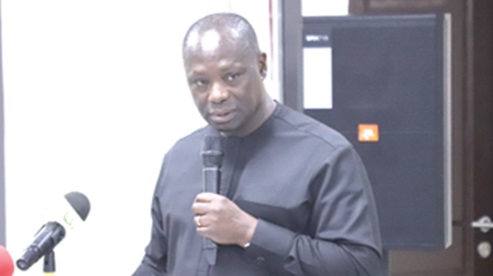The Minerals Commission has initiated an exercise to fit every earth-moving and mining equipment with a tamper-proof GPS tracker to significantly reduce the abuse of excavators in illegal mining and improve environmental governance, the Minister of Lands and Natural Resources, Emmanuel Armah-Kofi Buah, has told Parliament.
The minister said the move was to ensure that the equipment was tracked in real-time and used only in mining areas for which they had been registered.
“This is to ensure that we have eyes on the movement of each earth-moving and mining equipment, tracking as required under the Minerals and Mining (Mineral Operations Tracking of Earth-moving and Mining Equipment) Regulations, 2020 (L.I.12404) (LI 2404),” he said.
The instrument prescribes the mandatory registration of all earth-moving and mining equipment that is to be used in mineral operations.
Real-time monitoring
Answering questions on the floor of Parliament yesterday, Mr Buah said the trackers would be managed by a centralised Equipment Monitoring and Control Room currently set up and operated by personnel of the Minerals Commission.
“The control room operated 24 hours every day and can monitor the real-time location and movement history of all registered machines across the country, especially those operating in mining districts.
“As we speak, both the DVLA and Minerals Commission operate a 24-hour office at the Tema Port where all registration and tracking activities of this equipment take place,” he said.
He made this known when he responded to a question by the New Patriotic Party (NPP) Member of Parliament (MP) for Weija-Gbawe, Jerry Ahmed Shaib, who asked about the plan to establish an effective permit-issuance system and tracking mechanism for imported excavators to operationalise the directive of the President.
Importation regulation
The minister said the ministry remained committed to executing the President’s directive in full and called on all members of the House to support those efforts as “we move towards a more regulated, responsible, and sustainable extractive sector”.
Also, in collaboration with relevant agencies such as the Ministry of Transport, Ghana Revenue Authority (GRA) - Customs Division, Ports and Harbours Authority, Driver and Vehicle Licensing Authority (DVLA) and the Minerals Commission, the ministry was taking steps to establish a robust permit issuance and tracking system for imported earth-moving and mining equipment, particularly excavators, in line with the directive of the President, the minister stated.
He said the President had been clear and consistent in his commitment to addressing the scourge of illegal mining and its devastating impact on the environment and communities.
One of the critical control measures under the vision, Mr Buah stated, was the regulation of importation, clearance, registration and monitoring of all earthmoving equipment, particularly excavators.
To that end, he said the ministry, in collaboration with others, had developed a multi-agency framework to streamline the entire process from importation to operational monitoring.
Permit issuance
Mr Buah, also the MP for Ellembele, informed the House that the Ministry of Transport had been tasked with the responsibility of issuing import permits for excavators and related machinery.
He, however, said under the new framework, such permits would only be granted after the intended end-use of the equipment had been verified by both the DVLA and the Minerals Commission.
“This verification will determine whether the importer has a legitimate mining licence or is involved in lawful construction or infrastructural activity.
Once that is determined, the permit is issued,” he said.
Customs clearance and licensing
Mr Buah further highlighted the role played by the Ghana Revenue Authority (Customs Division) in the entire process.
He explained that customs officers at all designated ports of entry had been instructed only to allow clearance and gate out all earth-moving and mining equipment when an approved import permit was presented and endorsed by both the Ministry of Transport and the Commissioner General of GRA.
Besides, he said a special clearance code was being developed within the Integrated Customs Management System to track those permits and ensure accountability at every stage.
Once clearance was granted and equipment was gated out, he said the DVLA would assign a special identification number plate, distinguishable from the conventional number plates.

